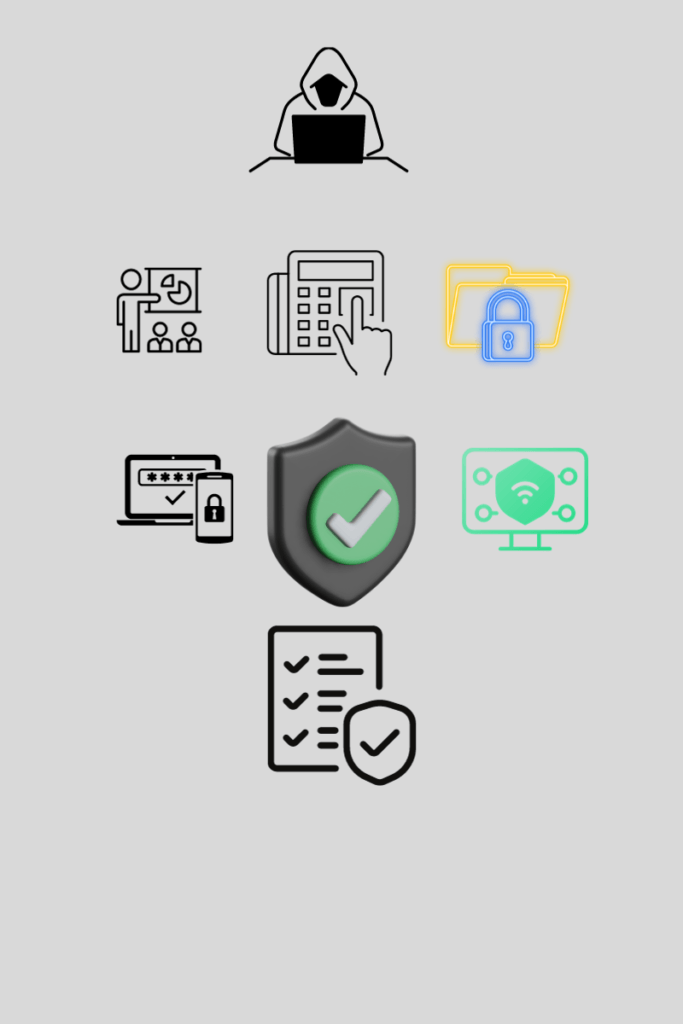What Are Advanced Persistent Threats?
With the increasing threat of cyber attacks, organizations need to be more vigilant in understanding advanced persistent threats (APTs). APTs are sophisticated, long-term attacks that infiltrate a network or system, often remaining undetected for an extended period. Unlike traditional attacks, APTs are specifically designed to evade detection and persist within a network, allowing unauthorized access and potential data breaches. This post will help you understand how to defend against APT attacks.

To effectively defend against APT attacks, organizations must take proactive measures to mitigate these threats.
An effective defense strategy includes:
- implementing comprehensive security measures
- constantly monitoring network activities for any signs of intrusion
- promptly responding to any potential breaches.
APT attacks exploit vulnerabilities in an organization’s infrastructure. This makes it crucial to regularly update and patch systems and employ strong access controls. Stay informed about the latest APT techniques and utilizing advanced security tools! By doing so, organizations can significantly reduce the risk of falling victim to these sophisticated cyber threats.
Key Takeaways
- APTs are long-term, sophisticated cyber attacks designed to remain undetected.
- Proactive defense strategies, including constant network monitoring and prompt response, are essential.
- Regular system updates and strong access controls can mitigate the risk of APT attacks.
- Understanding the stages of an APT attack helps in implementing effective defense measures.
What is the Anatomy of an APT Attack?

Advanced Persistent Threats (APTs) are highly sophisticated cyber attacks. They target organizations with the intent of gaining unauthorized access to sensitive information. The anatomy of an APT attack involves several stages, each carefully planned and executed by skilled attackers. Understanding these stages can help organizations implement effective strategies to defend against APTs and mitigate their impact.

What is the APT Attack Process Like?
The first stage of an APT attack is called reconnaissance. Reconnaisance is where the attackers gather information about the target organization and its vulnerabilities. This includes analyzing the organization’s network infrastructure, identifying potential entry points, and researching employees’ online presence. Once the attackers have gathered enough intelligence, they move on to the second stage, which is infiltration. At this stage, the attackers exploit vulnerabilities or use social engineering techniques. In doing so, they gain unauthorized access to the organization’s network or systems.
During the infiltration stage, the attackers establish a foothold and begin compromising various systems within the organization’s network. They may escalate their privileges and move laterally across the network to further their access and maintain persistence. The attackers then enter the next stage, which involves exfiltrating sensitive data from the compromised systems. This is done stealthily to avoid detection, often using encryption or disguising the data as benign network traffic. The final stage of an APT attack is the aftermath. This is where the attackers cover their tracks to remain undetected and potentially use the stolen data for malicious purposes.
To defend against advanced persistent threats, organizations should adopt a multi-layered security approach that includes both preventive and detective measures to help mitigate the risk of unauthorized access. :
- implementing strong endpoint protection solutions
- regularly patching vulnerabilities
- employing strict access controls
Additionally, organizations should monitor network traffic and employ advanced threat detection tools. These tools can identify anomalous behavior and indicators of compromise.
Consider building a robust incident response plan and conducting regular security assessments. These can also enhance an organization’s ability to respond effectively to APT attacks. By understanding the anatomy of an APT attack and implementing comprehensive defense strategies, organizations can better protect themselves from these highly sophisticated threats.
What are Common Entry Points for APT Attacks?
APTs, or advanced persistent threats, pose significant challenges in today’s cybersecurity landscape. These highly sophisticated attacks are carried out by skilled adversaries. These adversaries have the resources and determination to infiltrate target networks and remain undetected for extended periods. It is crucial to understand the common entry points to mitigate APT attacks. These entry points allow attackers to gain unauthorized access to networks.
One common entry point for APT attacks is through the distribution of malware. Attackers capitalize on unsuspecting users by disguising malicious software as legitimate files or links. Employees may inadvertently download malware by clicking on phishing emails or visiting compromised websites. With these points of entry, APT attackers can initiate an attack that may go undetected for months or even years.
Consequently, organizations must prioritize endpoint protection by implementing solutions to detect and block malware:
- robust antivirus software
- email filters
- web filtering
Additionally, ensure that employees are educated on the importance of cybersecurity. Teach them the risks associated with clicking on suspicious links or downloading files from unknown sources. By doing so, it can help prevent APT attacks.
What Are Best Practices for Mitigating APT Attacks?
APT attacks are a constant concern for organizations of all sizes. They have the potential to cause significant damage to both reputation and financial stability. Understanding how to defend against these sophisticated cyber threats is crucial in protecting sensitive data. Further, it can prevent extended periods of undetected malicious activity.
One of the most effective ways to mitigate APT attacks is by implementing strong access controls and user authentication mechanisms. This involves utilizing robust passwords, multi-factor authentication, and regularly updating user credentials. Additionally, organizations should carefully monitor and restrict access to critical systems and sensitive data. Thus, ensuring that only authorized personnel have permission to access them.

Another key best practice in defending against APT attacks is to regularly update and patch software and systems. Vulnerabilities in software and applications can provide an entry point for attackers to gain access to a network. By keeping software up to date and promptly fixing any identified vulnerabilities, organizations can significantly reduce the risk of APT attacks. Additionally, implementing a reliable firewall and intrusion detection system can help detect and block any malicious activity that may attempt to exploit these vulnerabilities.
How is Endpoint Protection a Key Defense Against APTs?
Endpoint protection plays a crucial role in safeguarding organizations against Advanced Persistent Threats (APTs). APTs are highly sophisticated and stealthy cyber attacks that often go undetected for extended periods. To effectively defend against APTs, organizations must implement strong endpoint protection measures that can identify and block these advanced threats before they gain a foothold in the network.
One of the primary ways APTs infiltrate systems is through compromised or weak authentication mechanisms. Attackers exploit vulnerabilities in user credentials and gain unauthorized access to the network. By deploying robust endpoint protection solutions, organizations can enforce strict authentication protocols and prevent unauthorized access attempts. This includes implementing measures such as two-factor authentication, strong password policies, and biometric authentication for additional layers of security. Endpoint protection tools also play a vital role in detecting and mitigating APTs that leverage social engineering tactics to trick users into divulging sensitive information.
How Should one Detect and Respond to APT Attacks
Detecting and responding to advanced persistent threat (APT) attacks is a critical component of any comprehensive cybersecurity strategy. APT attacks are highly sophisticated, often stealthy, and designed to avoid detection by traditional security measures. In order to defend against advanced persistent threats, organizations must have a thorough understanding of how APT attacks are conducted and be prepared to respond effectively.
Monitoring to Detect the Exfiltration of Data

One important aspect of detecting and responding to APT attacks is being proactive in monitoring for signs of unauthorized access and exfiltration of sensitive data. By implementing advanced threat detection tools and monitoring solutions, organizations can increase their ability to detect and respond to APT attacks in real-time. These tools can help identify unusual network activity, detect signs of APT malware, and monitor for any indications of an ongoing attack by an APT group. Additionally, organizations should focus on implementing strong access controls and regularly reviewing user access privileges to prevent unauthorized access and mitigate the risk of APT attacks.
Establish A Strong Incident Response Plan
To effectively defend against advanced persistent threats, organizations must also establish a strong incident response plan. This plan should include detailed procedures for detecting, containing, and eradicating APT attacks. It should clearly define the roles and responsibilities of the incident response team, outline the steps to be taken in the event of an APT attack, and establish communication channels for reporting and managing the incident. By having a well-defined incident response plan in place, organizations can minimize the impact of APT attacks and ensure a swift and effective response to mitigate security threats.
In conclusion, detecting and responding to APT attacks requires a proactive and comprehensive approach. It is crucial for organizations to invest in advanced threat detection tools and monitoring solutions, establish strong access controls to prevent unauthorized access, and develop a well-defined incident response plan. By following these best practices, organizations can enhance their ability to defend against APT attacks and protect their valuable data and networks from sophisticated cyber attacks.
What is the Role of Cybersecurity in APT Prevention?
When it comes to defending against Advanced Persistent Threats (APTs), cybersecurity plays a crucial role in preventing a successful attack. APTs are sophisticated and targeted attacks that aim to gain unauthorized access to sensitive systems and data over an extended period of time. To effectively defend against APTs, organizations need to implement a multi-layered approach that includes network traffic monitoring, robust endpoint protection, and a well-defined incident response plan.
One of the primary methods used by APT actors is phishing attacks, with spear phishing being particularly prevalent. These attacks target specific individuals within an organization with the intention of luring them into revealing sensitive information or providing access to the target network. By implementing strong cybersecurity measures such as advanced threat protection and antivirus software, organizations can significantly reduce the risk of falling victim to these attacks. Additionally, having an incident response plan in place that outlines how to detect and respond to APT attacks can help prevent initial breaches, as well as mitigate the potential damage if an attack is underway.
How can you secure Your Network from Unauthorized Access?
Securing your network from unauthorized access is crucial in defending against Advanced Persistent Threat (APT) attacks. APT attackers often use various attack vectors, such as phishing emails, to gain access to a network. Once inside, they remain undetected, establishing command and control channels to communicate with their malware and carry out their malicious activities. To prevent APT attacks, businesses of all sizes need robust cybersecurity measures in place.
How Do I Defend My Network Against APT Infiltration?
One of the primary goals of APT attackers is to infiltrate a network without detection. To defend against these sophisticated cyber threats, businesses must implement effective security controls and monitoring systems. This involves deploying advanced intrusion detection and prevention systems to identify suspicious activities within the network. Additionally, businesses should utilize data loss prevention tools to safeguard sensitive information and prevent unauthorized extraction or exfiltration of large amounts of data.
Patching Your System Will Reduce the Exploitable System Weaknesses
Furthermore, it is essential to consistently update and patch all software and applications within the network. By regularly applying security patches and keeping systems up to date, businesses can significantly reduce the likelihood of successful APT attacks. Additionally, conducting routine vulnerability assessments and penetration testing can help identify potential weaknesses in the network, allowing proactive measures to be taken in advance to mitigate potential risks.
Be Prepared: Having An Incident Response Plan

In the face of APT attacks, businesses must also establish an incident response plan tailored specifically for such threats. This plan should outline the steps to be taken when an APT attack is underway, including isolating affected systems, containing the spread of the attack, and initiating a thorough forensic analysis to understand the scope and impact of the breach. Equally important is the ability to quickly respond to and remediate the incident, minimizing the potential damage caused by the APT attack.
In conclusion, preventing advanced persistent threats requires a multi-layered approach that includes robust cybersecurity measures, continuous monitoring, regular patching and updating, as well as a well-defined incident response plan. By following these best practices, businesses can strengthen their defenses and better protect their networks against the ever-evolving landscape of APT attacks.
Are there Advanced Tools for APT Detection and Prevention?
In today’s evolving cyber threat landscape, organizations must adopt advanced tools for APT detection and prevention to stay ahead of attackers. Advanced Persistent Threats (APTs) are a type of targeted attack where attackers use sophisticated techniques to gain persistent access to a target network. These attacks are often associated with state-sponsored groups, such as Chinese APT groups, and pose a significant risk to organizations worldwide. With new APT tactics constantly emerging, it is crucial to deploy effective tools and take proactive steps to prevent APTs from compromising your network.
What is Advanced Endpoint Protection?
One of the key tools in defending against APTs is advanced endpoint protection. Traditional antivirus solutions may not be sufficient in detecting and stopping APTs due to their complex nature. By using advanced endpoint protection solutions, organizations can enhance their defenses through capabilities like behavior-based detection, machine learning, and threat intelligence integration. These tools analyze the behavior of files and processes in real-time, identifying any suspicious activities that may indicate an APT attack in progress. Additionally, using advanced endpoint protection solutions that incorporate security information and event management (SIEM) capabilities enables organizations to better monitor and respond to potential APT incidents. By correlating threat data from various sources and providing real-time alerts, SIEM enhances an organization’s ability to detect and mitigate APT attacks promptly.
With the evolving nature of cyber threats, organizations must stay vigilant and proactive in defending against APTs. By using advanced tools such as advanced endpoint protection and security information and event management, organizations can significantly bolster their defenses against APT attacks. However, it is also crucial to continuously stay informed about emerging threats and keep updating security measures to stay one step ahead of the attackers. Preventing APTs requires a multi-layered approach that includes not only advanced tools but also robust security practices, employee training, and ongoing monitoring. Building a strong defense against APTs is a continuous effort. Doing so can help organizations safeguard their valuable data and maintain the integrity of their networks.
How Can You build an Effective Incident Response Plan for APT Attacks?
Building an effective incident response plan is crucial for defending against Advanced Persistent Threat (APT) attacks. With the increasing sophistication of these attacks, organizations must take proactive measures to protect their data and assets. APT attackers are skilled at remaining undetected within a network for extended periods, allowing them to gain unauthorized access and carry out various types of attacks. One common technique used by APT attackers is known as “watering hole” attacks, where they compromise trusted websites frequented by their target victims. By infecting these websites with malware, attackers can compromise multiple targets without being detected easily.
To prevent such sophisticated attacks, organizations need to implement a strong incident response plan that focuses on proactive defense measures. The plan should encompass continuous monitoring and analysis of network traffic for any suspicious activities, as well as the implementation of robust security measures such as firewalls, intrusion detection systems, and advanced threat intelligence tools. In addition, organizations need to maintain strong access controls, ensuring that only authorized personnel can access sensitive data and systems. Regular security awareness training should be provided to employees to educate them about the risks associated with APT attacks and the best practices for protecting against them. By building an effective incident response plan, organizations can minimize the impact of APT attacks and swiftly respond to any potential security breaches.
Questions? We Have Answers.
Get answers to a list of the most Frequently Asked Questions.

Experienced cybersecurity analyst, software engineer, patent attorney, worked with Linux, Windows, AWS, lots of security tools. Hope to help people do the right things and do the things right!


